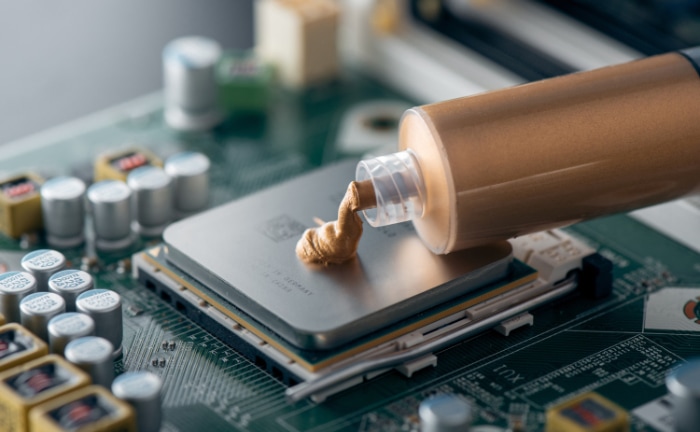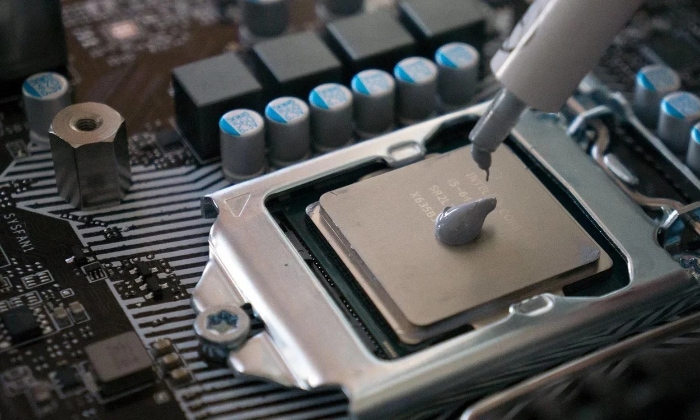Is Thermal Paste Necessary? The Hidden Costs of Skipping It

Cooling solutions for computer systems have evolved dramatically over the years, from basic fans to sophisticated liquid cooling setups. Yet, amid all these advancements, one tiny but crucial component often gets overlooked—thermal paste.
You might wonder, is this seemingly insignificant substance really essential to your computer's well-being? This question becomes even more pertinent as we continue to push the limits of computing power, demanding more from our machines while expecting them to run smoothly and efficiently.
The Role of Thermal Paste in Heat Dissipation
Often overshadowed by more noticeable cooling components like fans and heatsinks, thermal paste plays a critical but unseen role in maintaining optimal system temperatures.
What Thermal Paste Does at the Microscopic Level
Thermal paste serves as a conductive medium that fills in microscopic gaps between the heatsink and the CPU or GPU. These gaps occur due to imperfections in the manufacturing process and the natural roughness of metal surfaces.
When these tiny air pockets are present, they act as insulators, disrupting the efficient flow of heat from the CPU to the heatsink.
Physics of Heat Transfer
Heat transfer from the CPU to the heatsink occurs mainly through conduction. Thermal paste improves this process by ensuring a more seamless interface.
In technical terms, the paste increases the thermal conductivity between the two surfaces, allowing for faster and more efficient heat dissipation.
Importance of Thermal Conductivity
The thermal conductivity of a substance indicates how effectively it can transfer heat. Higher thermal conductivity means that the substance can move heat away from the heat source more quickly.
Most thermal pastes are designed to have high thermal conductivity, usually consisting of materials like ceramic and metal particles suspended in silicone.
Eliminating Air Gaps
Air is a poor conductor of heat, and the presence of air gaps hampers the heat transfer process. By filling in these gaps, thermal paste essentially eliminates the air barrier, thus ensuring that almost all generated heat is transferred to the heatsink and subsequently dissipated by the cooling system.
Impact on System Performance
Efficient heat dissipation directly affects system performance. Excessive heat can cause the CPU to throttle its speed to prevent damage, leading to reduced system performance.
By optimizing heat transfer, thermal paste plays a role in maintaining system performance, especially during resource-intensive tasks.
Comparing Thermal Paste with Alternatives
While thermal paste is a popular choice for enhancing heat dissipation in computer systems, it's not the only option available. Alternatives like thermal pads and direct metal-to-metal contact also exist.
However, each comes with its own set of pros and cons.
Thermal Pads as a Substitute
Thermal pads are essentially pre-cut pieces of thermally conductive material that you can place between the CPU and heatsink. They are generally easier to install than thermal paste, eliminating the need for precise application.
However, their thermal conductivity is often lower compared to most high-quality thermal pastes. This means they are less effective at transferring heat away from the CPU, which can impact system performance over time.
Metal-to-Metal Contact
Another approach to heat dissipation is direct metal-to-metal contact between the CPU and the heatsink. While this method seems straightforward, it has its drawbacks. Metal surfaces, no matter how finely polished, contain microscopic imperfections that create air gaps.
These gaps act as thermal insulators, impeding effective heat transfer. Additionally, direct contact may lead to corrosion over time, further affecting performance.
Comparison of Thermal Conductivity
When looking at the thermal conductivity values of these alternatives, thermal paste generally offers higher rates. High-quality thermal pastes can have thermal conductivity ratings above 10 W/m·K, while thermal pads often have ratings around 4-6 W/m·K.
Direct metal-to-metal contact can be inconsistent due to the reasons stated earlier, like surface imperfections and potential corrosion.
Ease of Application
Ease of application can be a decisive factor for some users. In this aspect, thermal pads often win as they are simple to place and require no spread.
Metal-to-metal contact requires no additional material but demands meticulous surface preparation to minimize air gaps. Thermal paste, while requiring a careful application, offers a middle ground in terms of complexity.
Reliability and Longevity
In terms of reliability and lifespan, thermal paste is often favored because it doesn't dry out as quickly as some thermal pads and is not subject to the same corrosion risks as metal-to-metal contact. Its properties make it a long-lasting solution, provided a high-quality paste is used and applied correctly.
Common Misconceptions About Thermal Paste

Thermal paste is a subject often accompanied by a plethora of myths and misconceptions, ranging from its importance to its application process. These false notions can lead to suboptimal cooling performance and even potential damage to your computer hardware.
Thermal Paste is Optional
One prevailing myth is that thermal paste is optional and skipping it won't have a significant impact on your system. The truth is, omitting thermal paste can result in inefficient heat transfer, leading to higher CPU temperatures, thermal throttling, and potentially, hardware failure.
All Thermal Pastes are Created Equal
Another common misconception is that all thermal pastes perform the same, regardless of their composition or brand. In reality, the thermal conductivity, viscosity, and longevity of thermal pastes can vary widely.
High-quality thermal pastes usually contain superior materials like ceramic and metal particles, offering better heat dissipation compared to generic or low-quality alternatives.
More is Better
Some users believe that applying a large amount of thermal paste will result in better cooling. However, too much thermal paste can actually be counterproductive.
An excessive amount can lead to spillage, possibly causing short circuits on adjacent components. The key is to apply just enough to cover the CPU surface evenly without overflowing.
Thermal Paste Never Needs Replacing
There's a notion that once applied, thermal paste lasts indefinitely. While it's true that high-quality thermal pastes can last for several years, they do eventually dry out and lose effectiveness.
Periodic replacement is recommended, especially if you notice a rise in CPU temperatures over time.
The CPU and Heatsink Don't Need Cleaning Before Application
Some people think that directly applying new thermal paste over old residue or without cleaning the surfaces is sufficient. This practice is incorrect and can lead to poor thermal conductivity. It's crucial to thoroughly clean the CPU and heatsink surfaces with isopropyl alcohol before any new application to ensure optimal heat transfer.
The Consequences of Skipping Thermal Paste
The use of thermal paste in computer systems is not merely a best practice but a necessity for efficient cooling. Opting to forgo this critical component can have several negative repercussions, some of which can be severe and long-lasting.
Overheating and Reduced System Stability
The most immediate consequence of not using thermal paste is the risk of overheating. Without the thermal interface material to fill microscopic air gaps, the efficiency of heat transfer between the CPU and heatsink drops significantly.
Overheating not only causes your system to be unstable but also increases the likelihood of unexpected shutdowns.
Thermal Throttling Affects Performance
Modern CPUs are equipped with mechanisms to protect themselves from overheating, one of which is thermal throttling. This reduces the CPU’s clock speed to lower its temperature.
While effective as a protective measure, throttling adversely impacts the system's performance, leading to lag and sluggishness during resource-intensive tasks.
Increased Wear and Tear on Cooling Components
The absence of thermal paste forces other cooling components like fans and liquid cooling systems to work harder to maintain acceptable temperatures. This results in faster wear and tear, reducing the longevity of these components and necessitating earlier replacements.
Risk of Permanent Hardware Damage
In extreme cases, the continued operation of an overheating CPU can result in permanent hardware damage. The excessive heat can weaken the integrity of the internal components, leading to malfunctions and, ultimately, system failure.
Long-Term Effects on System Lifespan
Ignoring the use of thermal paste can have a cumulative effect over time, reducing the lifespan of the computer system as a whole. Consistent overheating accelerates the aging process of various components, thereby shortening the overall life expectancy of your system.
How to Properly Apply Thermal Paste
The application of thermal paste is a straightforward yet crucial step in setting up an efficient cooling system for your computer. While the process may seem simple, a proper application is vital for optimal heat transfer between the CPU and the heatsink.
Preparing the Surface
Before you begin, it's essential to clean the surfaces of both the CPU and the heatsink. Use a lint-free cloth and isopropyl alcohol to remove any old thermal paste, dust, or oils.
This ensures that the new layer of thermal paste can adhere properly and provide effective heat conduction.
Selecting the Right Thermal Paste
Choosing the right thermal paste is important for achieving the best cooling performance. Look for pastes with high thermal conductivity values, as they will transfer heat more efficiently.
The paste should also be non-conductive to minimize the risk of short circuits.
Application Techniques
There are several methods to apply thermal paste, including the dot method, line method, and spreading method. Each has its merits:
- Dot Method: A small pea-sized dot of thermal paste is placed in the center of the CPU. When the heatsink is mounted, the pressure spreads the paste evenly.
- Line Method: A thin line of thermal paste is applied across the center of the CPU. Similar to the dot method, the pressure from the heatsink will spread the paste.
- Spreading Method: A thin layer of thermal paste is manually spread across the entire surface of the CPU using a plastic card. This method allows for more control over the paste distribution but can introduce air bubbles if not done carefully.
Securing the Heatsink
After applying the thermal paste, carefully align the heatsink over the CPU and secure it according to the manufacturer's instructions. Make sure the pressure is evenly distributed to ensure that the thermal paste spreads uniformly.
Testing and Monitoring
Once everything is assembled, it's advisable to monitor the CPU temperature using software tools. If the temperatures are within a safe range, it confirms that the thermal paste has been applied successfully.
Conclusion
Efficient heat dissipation is crucial for maintaining optimal performance and longevity in computer systems. Thermal paste plays a pivotal role in this aspect, acting as an essential intermediary between the CPU and heatsink.
While alternatives like thermal pads and direct metal-to-metal contact exist, they generally fall short in offering the same balance of thermal conductivity, reliability, and ease of application. Misconceptions about thermal paste often lead users astray, potentially causing overheating, reduced system stability, and even permanent hardware damage.
Proper application techniques can mitigate these risks, ensuring that your cooling system performs at its best. Therefore, the use of thermal paste is not just a recommendation but a necessity for any effective computer cooling solution.


